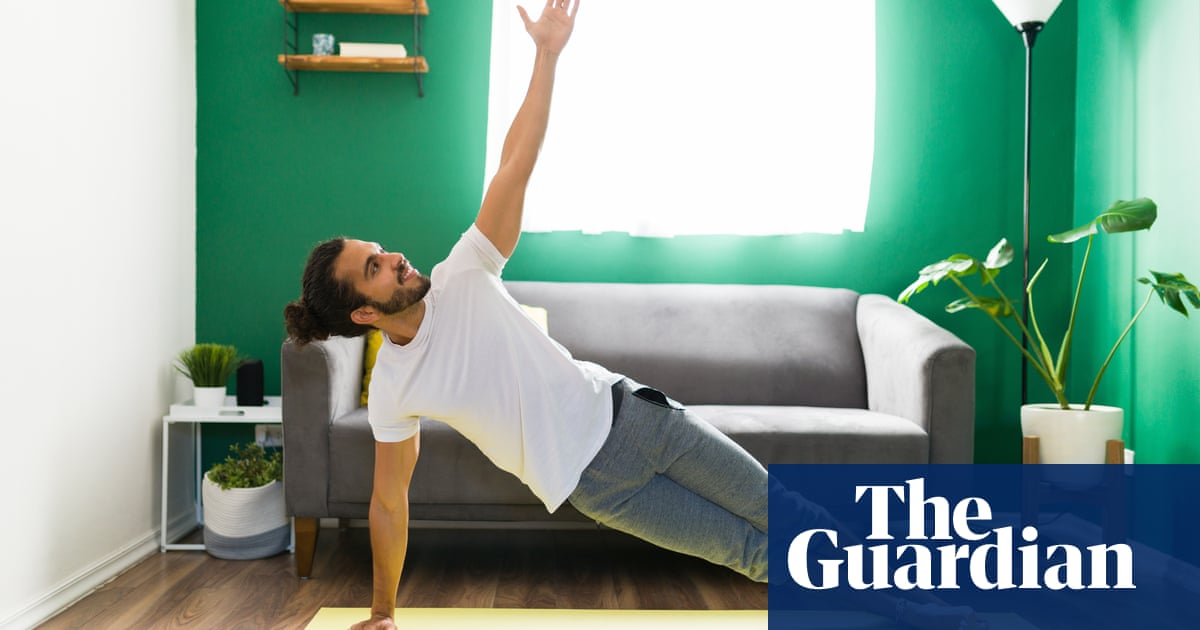
One of the toughest aspects of building a new year fitness habit is finding the time. Even in our hybrid-working world, it can feel like carving out just 30 minutes a couple of times a week is an impossible ask. But everyone has five minutes: it’s about a third as long as people spend looking for something to watch on Netflix. And although five minutes might not seem like much, if you keep your efforts focused, you will start to see results – as well as building the foundations of a longer-term habit. So pick an area to work on and get the egg timer going.
Posture
Desk jobs tend to build bad posture, and not everything you do in the gym will help – the typical “bench bro” routine can lead to a forward hunch that will set you up for problems down the line. “Posture is really about back strength,” says Helen O’Leary, a physiotherapist and clinical pilates instructor. “The more the muscles in the back of your body work, the more they will hold you up against gravity.” Use these three movements in a circuit, doing each once.
Prone press
“A great mobility and prep exercise to start with at the end of your day,” says O’Leary. “Lie on your stomach with your hands by your chest and your nose hovering above the floor. “Press your pubic bone into the floor to create a stable base. Press down into your hands and imagine you are pressing the floor away – this will start to send your upper back off the floor. Pause with your lowest ribs on the floor, take a breath and then lower back down. As you improve, try lifting your hands at the top of the movement to see if you can hold yourself up.”
Pilates swimming
“Very much a progression of the prone press – this will test your endurance as well as your core control,” says O’Leary. “Start as before, this time reaching your arms and legs away from each other as if you’re being pulled apart in a tug of war. You should end up with both feet and hands off the floor. Pause when you are here, and make sure you are breathing – then start to ‘paddle’ the arms and legs from the shoulder and hip socket. Your body will rotate a little and this is totally fine. Ideally, build the length of time you are up towards 60 seconds.”
Single leg kick
“It’s great for posture, but this movement also includes strength work around your shoulders, and will mobilise your spine,” says O’Leary. “Plus, your legs get involved, making it an all-in exercise. Lie on your front and press yourself up on to your elbows to make a triangle shape with your forearms, with your hands still slightly apart. Press down into your pubic bone and extend and raise one leg away from you so that it starts to hover off the floor from your lower thigh onwards. Now try to keep that leg off the floor as you start to draw a long arc upwards and outwards with your toes, bending the knee as you do. Again, keep the thigh off the floor and extend the leg out behind you before lowering it to the floor. Repeat five times on each leg, if you can.”
Core strength
This is important for everyday life, but tackling it the old-school way – with hundreds of momentum-heavy sit-ups – isn’t efficient. Instead, remember that the real purpose of your core muscles is to keep you braced, whether you are carrying the shopping or doing a parallel turn on the ski slopes – so you need to focus on slow, controlled movements that will help them do their job. Do each of the three exercises below for 40 seconds, rest for 10-20 seconds, and repeat.
Crunch
“Although it’s an old exercise, when performed with correct form, the standard crunch is great, as it activates nearly all the muscles of the core,” says the personal trainer Jacqui Ward. “Lie on your back, keeping your knees bent and feet flat on the floor, making sure your lower back is also pressed into the floor. Engage your abdominal muscles to lift your head and shoulders off the floor. I like to increase the time under tension, while at the top part of the crunch, by pausing for a second, and then slowly lowering back to the floor with control, keeping those abs contracted. If you really must put your hands behind your head, don’t pull on your head or neck.”
Bicycle crunch
“Again, technique is everything on this movement,” says Ward. “Get into a regular crunch position, then lift both legs off the ground. Lift your right shoulder toward your left knee and simultaneously extend your right leg, then repeat on the opposite side without pausing. Make sure to move slowly and emphasise muscle contraction to get the most out of the exercise.” This emphasises your obliques more than the standard crunch, so it’s worth doing both.
Side plank raise
“A side plank is a great movement, as it will show up any imbalances between your two sides,” says Ward. “To start, lie on your side with one forearm on the ground, your hand slightly in front of your shoulder. Put your top leg either in front or on top of the ‘grounded’ leg. As you exhale, push into your hand and feet, and lift your hips up until you are in a diagonal line. Drop your hips down, then press into your hand and feet and lift your hips back up so that they are almost in line with your shoulder. Repeat this movement, slow and controlled rather than bouncing, for 20 seconds on each side – if it’s tough on your wrist, press your fingers into the floor and create a little dome in your palm.”
Mobility
Whether you’re a runner who doesn’t do much else, or an avid gamer who only has time to stretch during the loading screens, a little goes a long way when it comes to mobility exercises. For an all-round hit, try the “slow burpee”, which engages almost every muscle you have. Start standing with your feet just outside shoulder width apart, then squat down, placing your hands between your legs. Walk your hands out into a push-up position, directly under your shoulders. Do one push up, then reverse the movement, stand up, breathe and repeat. Do them ladder-style: one rep, one breath, two reps, two breaths … up to five or 10.
Strength
It’s tough to build real strength doing five minutes a day – Olympic weightlifters will often rest for up to five minutes between heavy sets – but if you want to make a start in the time you have, try staying still. “In that kind of time frame with no equipment, isometrics [the tightening of a specific muscle or group of muscles] aren’t a bad option,” says strength coach Joseph Lightfoot. “You don’t need to warm up much, and there’s basically no risk of injury.” Pair the movements below a couple of times a week.
Press-up hold
Starting from a high plank (ie as if you were at the top of a press-up), lower yourself until your elbows are bent to a roughly 90–degree angle, then hold for 30-60 seconds. Keep your elbows tucked to your body and your body plank-straight – this will also build core strength.
Squat holds
Squat down until your upper thighs are parallel to the floor and hold the position for 30-60 seconds, keeping your torso upright and head high. Too easy? Move on to the single leg squat hold by putting one leg behind you, keeping your trailing knee hovering just above the floor, without putting the foot to the ground.
Hip flexibility
For anyone who is not particularly active, building flexibility and mobility around the hips is key: it’s the biggest bang for your buck in terms of improving overall quality of life. “Just a few simple hip-openers can improve the external rotation of the femur bone in the hip socket and improve your flexibility,” says Helen Gaunt, an elite runner and personal trainer. “Use these three for 45-60 seconds each – or on each side – and try to do them a few times a week.”
Bound angle pose
You may also know this one as the butterfly stretch: it’s great for the inner thigh muscles, or adductors. In a seated position, bring the flats of the feet together, holding them in your hands with your knees out to the sides. Inhale and then exhale, dropping your shoulders as you push your knees downwards towards the ground, keeping your head tall, and back straight. This can also be done against a wall for support – or leaning forwards, pushing the elbows down on to your thighs.
Figure of four
Lie on the floor facing upwards, lift both legs and bend them, keeping one foot on the floor and bringing the other ankle across to rest against the opposite knee – you should feel a slight stretch in that leg. Lace your hands behind the thigh of the non-stretching leg and pull it towards you to increase the stretch, but not so much that it’s uncomfortable. Hold, then repeat on the other side.
Child’s pose
Finish with this relaxing hip-opener position. Kneeling with your knees open and your feet together, hinge at the hips, lowering your upper body forwards, bringing your head down towards the floor and reaching your arms forwards to stretch out the upper back. Hold for at least 60 seconds, inhaling and exhaling slowly and deeply, releasing and loosening the hips and pelvis to improve range of movement.
Fat loss
The four-minute Tabata intervals workout programme beloved of gym classes is slightly overrated: in the studies that showed its effectiveness, professional athletes warmed up for 20 minutes before even starting the protocol, and did their sets at 170% of VO2 max (100% of V02 max is often “associated with complete exhaustion and/or vomiting”). Still, if time is short and you’re aiming to burn some fat, one move beats all the others: a Louisiana University study that compared kettlebell swings, cleans and deadlifts to a more traditional sprint training programme found that calorie expenditure was biggest with the bells.
To master the kettlebell swing, stand with your feet just outside shoulder-width and the kettlebell hanging from both hands. Bend your knees and hinge your hips slightly, then snap your hips forward, using the momentum to swing the bell upward. Weight-wise, don’t go too light; if you can use your arms to do the reps, you can go heavier.












